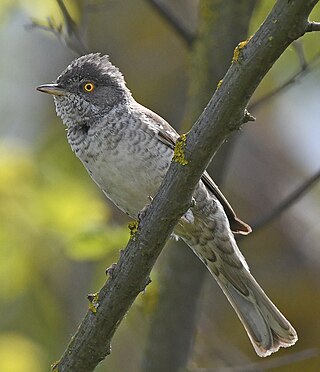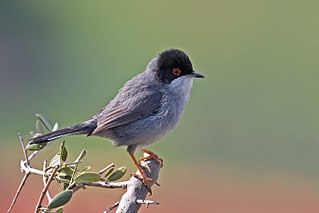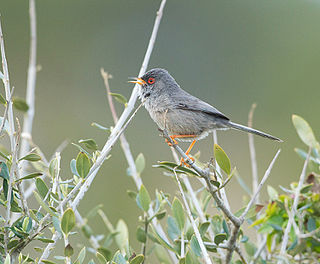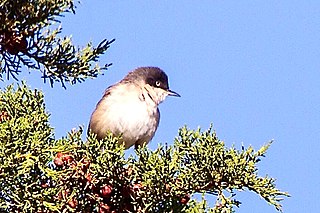Old World warblers are a large group of birds formerly grouped together in the bird family Sylviidae. They are not closely related to the New World warblers. The family held over 400 species in over 70 genera, and were the source of much taxonomic confusion. Two families were split out initially, the cisticolas into Cisticolidae and the kinglets into Regulidae. In the past ten years they have been the subject of much research and many species are now placed into other families, including the Acrocephalidae, Cettiidae, Phylloscopidae, and Megaluridae. In addition some species have been moved into existing families or have not yet had their placement fully resolved. A smaller number of warblers, together with some babblers formerly placed in the family Timaliidae and the parrotbills, are retained in a much smaller family Sylviidae.

The barred warbler is a typical warbler which breeds across temperate regions of central and eastern Europe and western and central Asia. This passerine bird is strongly migratory, and winters in tropical eastern Africa.

The common whitethroat or greater whitethroat is a common and widespread typical warbler which breeds throughout Europe and across much of temperate western Asia. This small passerine bird is strongly migratory, and winters in tropical Africa, Arabia, and Pakistan.

The Sardinian warbler is a common and widespread typical warbler from the Mediterranean region. Like most Curruca species, it has distinct male and female plumages. The adult male has a grey back, whitish underparts, black head, white throat and red eyes. Plumages are somewhat variable even in the same locality, with the intensity of a reddish hue on upper- and/or underside that varies from absent to pronounced. The female is mainly brown above and buff below, with a grey head. The Sardinian warbler's song is fast and rattling, and is very characteristic of the Mediterranean areas where this bird breeds.

The Cyprus warbler is a typical warbler which breeds only on Cyprus. This small passerine bird is a short-distance migrant, and winters in Israel, Jordan and Egypt.

The lesser whitethroat is a common and widespread typical warbler which breeds in temperate Europe, except the southwest, and in the western and central Palearctic. This small passerine bird is strongly migratory, wintering in Africa just south of the Sahara, Arabia and India.

The Dartford warbler is a typical warbler from the warmer parts of western Europe and northwestern Africa. It is a small warbler with a long thin tail and a thin pointed bill. The adult male has grey-brown upperparts and is dull reddish-brown below except for the centre of the belly which has a dirty white patch. It has light speckles on the throat and a red eye-ring. The sexes are similar but the adult female is usually less grey above and paler below.

Balearic warbler is a typical warbler, genus Curruca. It is endemic to the Balearic Islands, apart from Menorca. It groups with the Marmora's warbler, Tristram's warbler and the Dartford warbler.

Rüppell's warbler is a typical warbler of the genus Curruca. It breeds in Greece, Turkey and neighbouring islands. It is migratory, wintering in northeast Africa. This is a rare vagrant to western Europe. The name is occasionally cited as "Rueppell's warbler".

The western Orphean warbler is a typical warbler of the genus Curruca. This species occurs in summer around the Mediterranean, through western Europe and extending into northwest Africa. It is migratory, wintering in Sub-Saharan Africa. It is a rare vagrant to northern and north-western Europe.

Marmora's warbler is a typical warbler in the Sylviidae family. The specific sarda is a Latin feminine form for a person from Sardinia.

The spectacled warbler is a species in the typical warbler genus, Curruca. The specific conspicillata is from Latin conspicillum, a place to look from, equivalent to "spectacled".

The chestnut-vented warbler, chestnut-vented tit-babbler or rufous-vented warbler is an Old World warbler.

The banded parisoma, banded tit warbler or banded warbler, is a species of Old World warbler in the family Sylviidae. It is found in Ethiopia, Kenya, Somalia, and Tanzania. Its natural habitat is dry savanna.

The Yemen warbler or Yemen parisoma is a species of Old World warbler in the family Sylviidae. It is found on the southeastern slope of the Sarawat Mountains of Yemen and Saudi Arabia, where its natural habitat is subtropical or tropical dry forests. It is threatened by habitat loss and the International Union for Conservation of Nature has assessed its conservation status as being "Near Threatened".

Curruca is a genus of Sylviid warblers, best represented in Europe, Africa, and Asia. All of these species were formerly placed in the genus Sylvia.


















